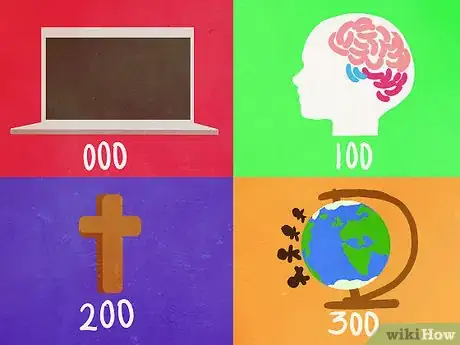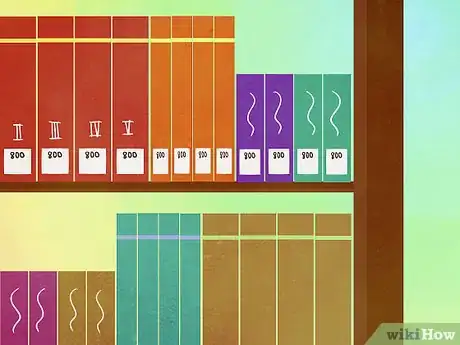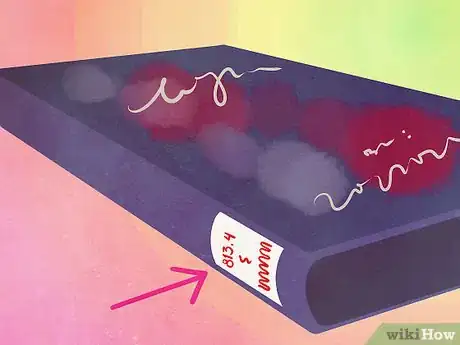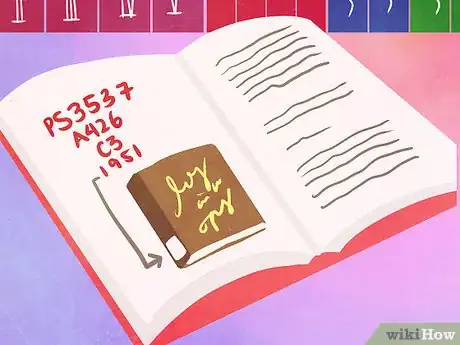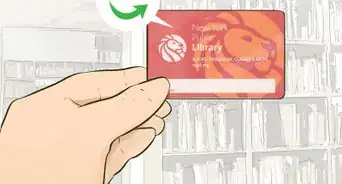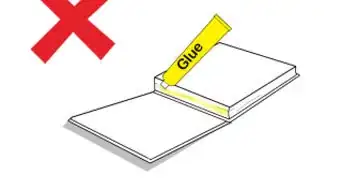This article was co-authored by Kim Gillingham, MA. Kim Gillingham is a retired library and information specialist with over 30 years of experience. She has a Master's in Library Science from Kutztown University in Pennsylvania, and she managed the audiovisual department of the district library center in Montgomery County, Pennsylvania, for 12 years. She continues to do volunteer work for various libraries and lending library projects in her local community.
wikiHow marks an article as reader-approved once it receives enough positive feedback. In this case, 80% of readers who voted found the article helpful, earning it our reader-approved status.
This article has been viewed 214,560 times.
If you are thinking of volunteering or getting a job at a library, you will need to know how to shelve the library books. All library books in all libraries are shelved according to either the Dewey Decimal System or the Library of Congress Classification System. While many university and specialty libraries use the Library of Congress Classification System, most public libraries, elementary and high schools shelve their books according to the Dewey Decimal System.
Steps
Shelve Books According to the Dewey Decimal System
-
1Learn how the Dewey Decimal System works. Learning the system is not difficult because it is logically organized and built on a decimal base. Essentially, every class of book is assigned a category number (a whole number, such as 800) and a cutter number or numbers (numbers to the right of the decimal point).[1] These are the numbers you see on the spine of a library book, and they are referred to as the call number. The system is comprised of ten classes, which are further divided into 10 more subcategories, and each of those subcategories contains 10 subdivisions. The 10 main classes of the Dewey Decimal System are:[2]
- 000—Computer science, information and general works
- 100—Philosophy and psychology
- 200—Religion
- 300—Social Sciences
- 400—Language
- 500—Science
- 600—Technology and applied science
- 700—Arts and recreation
- 800—Literature
- 900—History and geography
-
2Remember that the purpose of call numbers is to group books of the same subject together, and is comprised of at least two parts: the Class number (000 through 900) and the cutter number. The class number is a whole number and the cutter number(s) are placed after the decimal point.[3]Advertisement
-
3Get a feel for how a classification is broken down.[4] Here is a short example of how you would find or shelve a book about American fiction literature written between 1861 and 1900. (The broad classification for literature is “800.”)
- Look at the second number after the “8.” The number “1” indicates that the book is further classified as “American literature in general.” The second number after the “8” further defines the division; 811 is American poetry, 812 is American Drama, 813 is American fiction, 814 is American essays and so on.
- Look at the first number after the decimal point; this number refines the classification even further. Thus, a book with a call number of “813.4,” tells you that the book is American fiction written between 1861 and 1900. Obviously, the more numbers, the more specific the subject.
How to Shelve Books According to the Library of Congress Classification System
-
1Learn the 20 classifications the Library of Congress uses to separate areas of knowledge. Each class corresponds to a letter of the alphabet.[5]
- A General Works
- B Philosophy-Religion-Psychology
- C History (Civilization)
- D History (Except America)
- E American History
- F Local American history, Latin American History
- G Geography and Anthropology
- H Social Sciences
- J Political Science
- K Law
- M Music
- N Fine Arts
- P Language and Linguistics
- Q Science and math
- R Medicine
- S Agriculture
- T Technology
- U Military Science
- V Naval Science
- Z Bibliography and Library Science
-
2Read more about how each class is further subdivided into subclasses, using a combination of letters and numbers. As with the Dewey Decimal System, the more numbers and letters contained in a call number, the more specific the classification is—and the easier it is to find or shelve the book.[6] The LC call number “PS3537 A426 C3 1951,” identifies the “Catcher in the Rye,” by J. D. Salinger, which was published in 1951 (the last four numbers in the call number.)
Community Q&A
-
QuestionWould historical fiction books be classified under fiction or history?
 Community AnswerAll books that qualify as fiction would be classified under fiction. The history section is for non-fiction historical titles.
Community AnswerAll books that qualify as fiction would be classified under fiction. The history section is for non-fiction historical titles. -
QuestionHow are children's books shelved?
 Community AnswerShelve them alphabetically by author surname in the category they are in: easy reader, picture books etc.
Community AnswerShelve them alphabetically by author surname in the category they are in: easy reader, picture books etc. -
QuestionHow do I shelves books with four letters and four numbers?
 Amy FlugelCommunity AnswerIf you mean books that have fewer numbers/letters, it depends. Drew would come before Drewer, because spaces after letters are treated as coming before the letter A. With numbers, 793.4 comes before 793.43, but it comes after 793.389.
Amy FlugelCommunity AnswerIf you mean books that have fewer numbers/letters, it depends. Drew would come before Drewer, because spaces after letters are treated as coming before the letter A. With numbers, 793.4 comes before 793.43, but it comes after 793.389.
Warnings
- New library employees or volunteers are not expected to know the entire Dewey Decimal or Library of Congress classification systems. However, make sure you at least know the 10 main classifications, and the first 10 subdivision of each classification.⧼thumbs_response⧽
References
- ↑ John Gillingham, CPA, MA. Certified Public Accountant & Founder of Accounting Play. Expert Interview. 3 March 2020.
- ↑ https://wadslib.com/wp-content/uploads/2016/01/Dewey.pdf
- ↑ https://wadslib.com/wp-content/uploads/2016/01/Dewey.pdf
- ↑ https://piercecountylibrary.silkroad.com/map_images/main/SiteGen/PCLSEXT/Content/Uploads/Unplaced_Documents/Book_Shelving_9.8.11.pdf
- ↑ https://www.angelo.edu/services/library/handouts/lcnumber.php
- ↑ https://www.angelo.edu/services/library/handouts/lcnumber.php
- http://www.loc.gov/catdir/cpso/lcco/
About This Article
The most common way to shelve books in a library is to use the Dewey Decimal System, which groups books of the same subject together. With this system, every book is categorised into 10 main sections. For example, 100 is “Philosophy and Psychology,” 500 is “Science,” and 800 is “Literature.” Within each category, there are subcategories which have their numbers in the 10s place. Within each subcategory, there are more classifications, which are shown in the ones place. For instance, a book with a call number of “813.4,” tells you that the book is American fiction written between 1861 and 1900. For more tips, including how to shelve books using the Library of Congress Classification System, read on!
